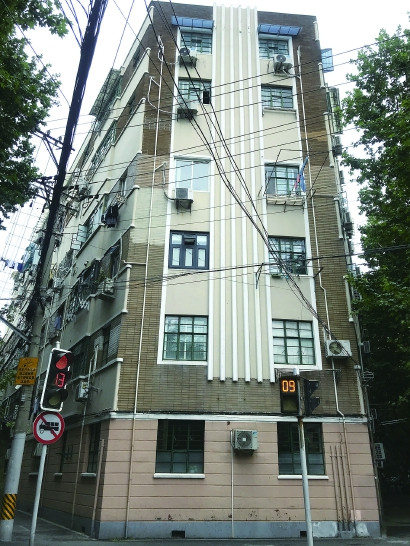Zhang Junxiang, pen name Yuan Jun, a native of Zhenjiang, Jiangsu, is a Chinese film and drama director, playwright and theorist. Among the older generation of Chinese film directors, Zhang Junxiang is one of the few "returnees" who studied for a master's degree at the Yale University Theater Research Institute. Zhang Junxiang's wife, Zhou Xiaoyan, a famous vocal pedagogue in China, lived for a long time on Fuxing West Road in Shanghai.

Pictured: Liangyou Apartment Xinmin Evening News reporter Cai Jin photo
Villa Rose bears witness to love
In 1931, at the age of 21, Zhang Junxiang graduated from the Department of Foreign Literature of Tsinghua University and stayed on as a teaching assistant to study Western drama. In 1936, he entered the Yale University Academy of Drama in the United States, received a master's degree in fine arts in 1939, and taught at the Jiang'an National Drama College in Sichuan after returning to China in the same year.
Zhang Junxiang has always condensed his patriotic feelings in his pen, and has written drama scripts such as "Story of Mountain City", "Story of Small Town", "Story of Border City", "Table of The Master of Wanshi", "President of the United States", translated "Good Hope", "Judgment Day", "Rich and Floating Clouds", "Lincoln in Illinois" and other European and American drama masterpieces, and also directed classic dramas such as "Metamorphosis", "Beijinger", "Requiem", "Romeo and Juliet", "Cowherd Weaver Girl", "Dadu River" and other classic dramas.
After the victory of the War of Resistance Against Japanese Aggression, Zhang Junxiang transformed from drama to the film industry and became a rare artist, educator, theorist, translator and careerist in the Chinese film industry. As a director, he left classic business cards such as "Homecoming Diary", "Cuigang Red Flag", "Doctor Bethune", "Liao Yuan", "Daze Dragon Snake", and created film scripts such as "Victory Reunion" and "Chicken Feather Letter"; he also made a lot of achievements in film theory, publishing the collection of essays "On the Special Means of Expression of Film", "Trivia of Film Affairs" and the systematic introduction of Alexander Dean's essay collection "The Art Foundations of Directing", and also participated in the editor-in-chief of the "Dictionary of Chinese Cinema". In the 1960s, he participated in the establishment of the Shanghai Film College and personally served as its principal, training a large number of film professionals.
In 1952, Zhang Junxiang married Zhou Xiaoyan, a flower soprano singer and vocal educator, in Shanghai. Shortly after the marriage, Zhang Junxiang and Zhou Xiaoyan moved into the 2nd floor of Rose Villa, Lane 44, Fuxing West Road. There are 7 garden villas in Lane 44, Fuxing West Road, built between 1937 and 1945, with three floors of brick and wood structure, all of which are flat roofs, cement mortar exterior walls, simple architectural shapes, reflecting modern architectural styles, and there is a garden in front of the house. When it was built, the ground of Nongkou was ingeniously built with the word "rose", so it was called "Rose Villa" by many old Shanghainese.
Used to live in a good friend apartment
In addition to the Rose Apartment, Zhang Junxiang also lived in the Liangyou Apartment on Fuxing West Road. In addition to Zhang Junxiang, there are also famous foreign literary translators Luo Jinan, flying elders who flew to the motherland, academicians of the textile industry, and Tan Ningbang, an American who starred in the movie "Bethune".
Liangyou Apartment is located at the current Fuxing West Road No. 91 and 93, because it is located at the intersection, it is arranged according to the road topography, and the plane is slightly A-shaped. According to the data, Liangyou Apartment was completed in 1936, covering an area of 520 square meters, with a construction area of 2452 square meters, a 6-storey brick-concrete structure, and a late Art Deco style. The façade emphasizes the horizontal composition, with red glazed brick walls on the ground floor, brown sintered brick walls above the second floor, and white cement walls highlighting horizontal lines between floors. There are 6 apartments of various sizes on each floor, which are still residential. Liangyou Apartment has three entrances and exits, two on Fuxing West Road and one on Yongfu Road. In 2015, Liangyou Apartment was rated as an outstanding historical building in Shanghai.
Xinmin Evening News reporter Shen Qihua